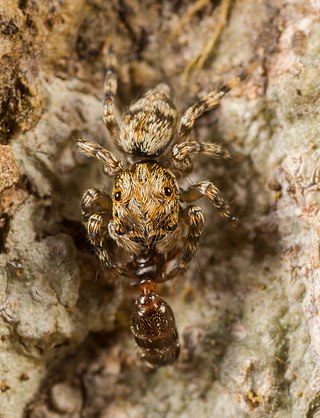Habrocestoides is a genus of the spider family Salticidae. Most species are endemic to India, with H. phulchokiensis found only in Nepal.

Habrocestum is a genus of jumping spiders first described in 1876. They mostly occur in Eurasia and Africa, though one species has been found in Australia and another on the Solomon Islands.
Habrocestum albopunctatum is a jumping spider species that lives on the Socotra Archipelago off the coast of the Yemen. It was first described in 2002.
Habrocestum auricomum is a jumping spider species in the genus Habrocestum that lives in South Africa. It was first identified in 2013.
Habrocestum dubium is a jumping spider species in the genus Habrocestum that lives on the Socotra Archipelago off the coast of the Yemen. The female was first described in 2002.
Habrocestum ferrugineum is a jumping spider species in the genus Habrocestum that lives on the Socotra Archipelago off the coast of the Yemen. The female was first described in 2002.
Habrocestum formosum is a jumping spider species in the genus Habrocestum that lives in Zimbabwe. It was first described by Wanda Wesołowska in 2000.
Habrocestum gibbosum is a jumping spider species that lives in the Yemen. It was first described in 2007.
Habrocestum ignorabile is a jumping spider species in the genus Habrocestum that lives in the Yemen. It was first described in 2007.
Habrocestum inquinatum is a jumping spider species in the genus Habrocestum that lives on the mainland in Yemen and the Socotra Archipelago. The female was first described in 2002. The spider shares similarities with Habrocestum gibbosum, living in a similar geography and sharing morphological characteristics.
Habrocestum naivasha is a species of jumping spiders that lives in Kenya. It was first described in 2016.
Habrocestum personatum is a jumping spider species that lives in Nigeria. It was first described in 2011.
Habrocestum namibicum is a jumping spider species in the genus Habrocestum that lives in Namibia. It was first described by Wanda Wesołowska in 2006.
Habrocestum socotrense is a jumping spider species in the genus Habrocestum that lives on the Socotra Archipelago off the coast of the Yemen. Its species name is derived from the location where it was first identified in 2002.
Habrocestum speciosum is a jumping spider species in the genus Habrocestum that lives on the Socotra archipelago off the coast of Yemen. It was first described in 1994.
Habrocestum superbum is a jumping spider species in the genus Habrocestum that lives in Zimbabwe. It was first described by Wanda Wesołowska in 2000.
Habrocestum tanzanicum is a jumping spider species in the genus Habrocestum that lives in Tanzania, after which its species name is derived. It was first described in 2000.
Habrocestum virginale is a jumping spider species in the genus Habrocestum that lives in the Yemen. It was first described in 2007.

Irura mandarina, also known as the Goldenback jumping spider, is a species of jumping spider found in China, Vietnam and India.

Dexippus pengi is a species of jumping spider found in China and India.



